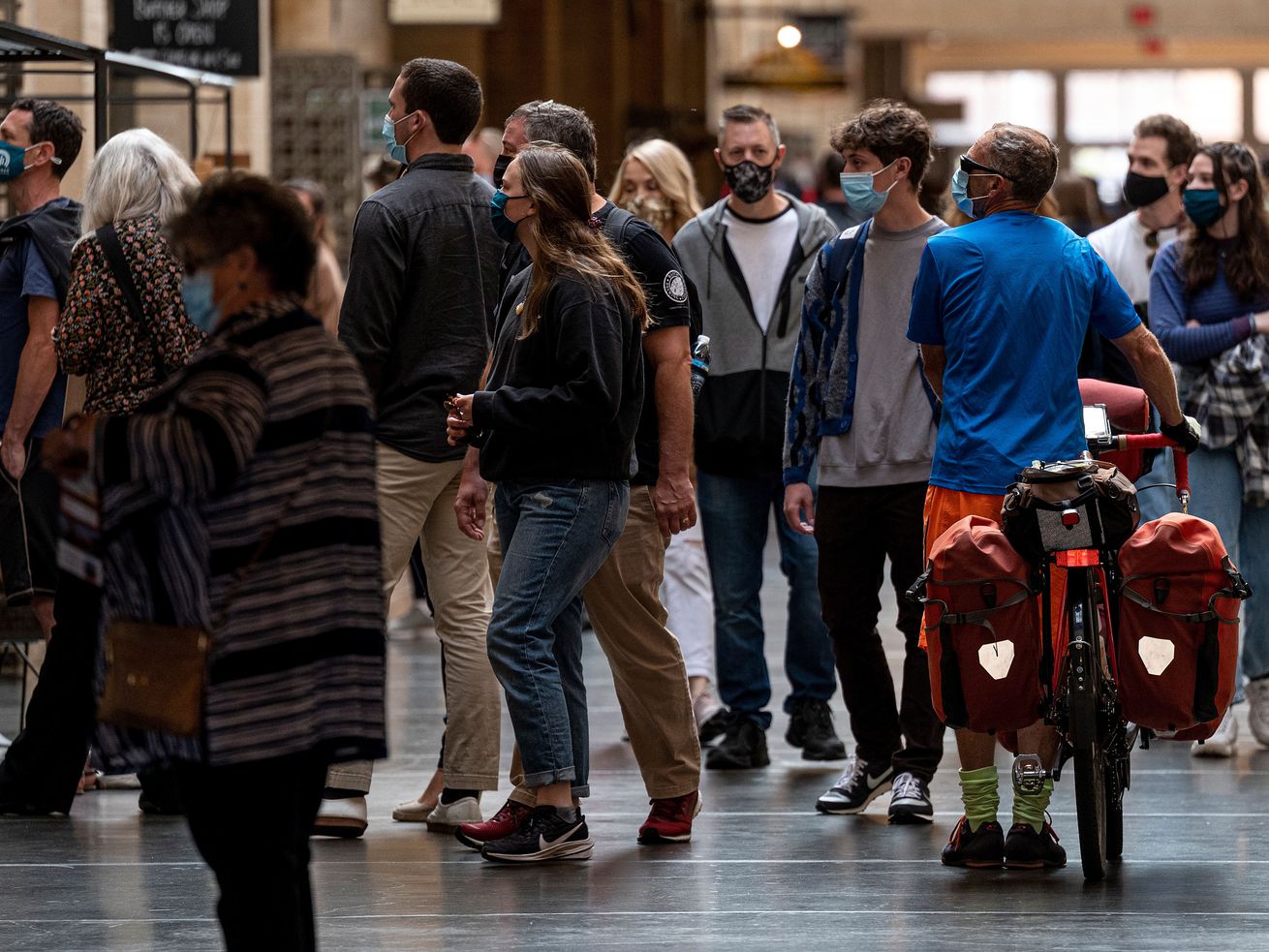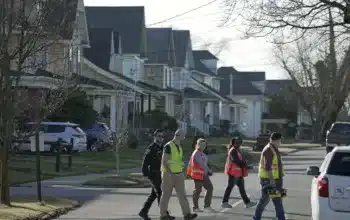An expert explains why vaccinated people should wear masks in some indoor settings.
The Centers for Disease Control and Prevention has now done an about-face on its masking guidelines for people vaccinated against Covid-19. Back in May, the agency said that people who are fully vaccinated against Covid-19 could “resume activities without wearing masks or physically distancing.”
But the new CDC guidance issued in late July says that vaccinated people should “wear a mask indoors in public if you are in an area of substantial or high transmission.” Even where transmission rates aren’t as high, immunized people with weakened immune systems, and the people they live with, should also consider it.
Why the change?
The far more contagious delta variant of the virus that causes Covid-19 has rattled health officials. Beyond its rapid spread, the delta variant appears to cause more serious illness. It also seems better able to elude immune protection from vaccines and prior infections. Some breakthrough infections have been reported among vaccinated people, although the majority seem to lead to few, if any, symptoms. And while the vaccination rate has started to pick up again, it’s still far below its peak in April. Tens of millions of Americans remain unvaccinated, and in some regions of the US, less than 30 percent of people are immunized.
Kate Grabowski, a researcher at Johns Hopkins University who studies the dynamics of infectious disease, talked to Vox about how masks fit into the public health strategy during the current stage of the pandemic. From her home state of Maryland, she explained the CDC’s difficult balancing act as it encourages vaccinations and masking at the same time.
Our conversation has been edited for length and clarity.
What do these new guidelines mean, and how will they change our lives?
At this point, we’re seeing a lot of cities and states across the country emerge as high-transmission areas. I would advise vaccinated people, particularly those who might be at higher risk, to wear masks in indoor settings regardless of where they are in the country. So, what does this mean in terms of their lives? Vaccinated people will have to get used to wearing masks indoors in places like grocery stores or movie theaters, like we’ve been doing for the past year and a half.
One of the major questions is how effective these measures will be. This depends on where transmission is occurring. If people in a high-transmission area aren’t wearing masks at restaurants indoors, for example, or at intimate social gatherings, those mandates might not be as effective.
Some cities have not yet implemented mask mandates. What is the effectiveness of mask use for individual protection indoors, if people around you aren’t complying?
If you’re looking for protection at an individual level in settings where people aren’t wearing masks, you’re going to need something stronger, like a high-quality surgical mask or ideally an N95. N95s offer pretty good protection for the wearer. If you’re a high-risk person, you shouldn’t be going to the gym or a restaurant where few people are wearing masks around you.
Last year, when we implemented cloth mask mandates, it was more of an intervention on a population level, although it’s likely cloth masks provide some minimal protection for the wearer. If everyone wears masks, we can reduce transmission by 10 to 20 percent. At the population scale — when you’re talking about millions of infections and hundreds of thousands of deaths — even relatively weak interventions are helpful. It could save thousands of lives.
Should the general public expect more updates to the CDC’s mask guidance?
I think we can expect changes at the local level. It’s unclear what the CDC will say, but we should always expect public health guidelines to change. As we learn more about the virus and variants, guidance shouldn’t be static. We have to be prepared to adapt.
I worry that people are going to say, “I got vaccinated, so I’m done with this pandemic.” I have generally been an optimist, but the data I’m seeing on the delta variant with the rise of cases and hospitalizations, particularly in states like Arkansas, Louisiana, and Florida, are really concerning. We’re seeing upticks even here in Maryland.
There is this assumption that we’re masking up to protect the unvaccinated, but we’ve seen plenty of breakthrough infections, so millions of people are still vulnerable even if they’re vaccinated. It’s not just protecting the unvaccinated; it’s everyone. Luckily, it doesn’t look like these breakthrough infections are too severe at this point. But we still have to deal with the unknowns: how long the vaccines will offer protection against severe disease or death. We simply don’t know, because we haven’t followed people long enough to see. Maybe it’ll be for a very long time, or maybe there will be new variants. We really do not know at this time.
Does this mean that the CDC’s previous recommendation — that fully vaccinated people can stop wearing masks — was premature, or the wrong decision?
The CDC is in a tough spot. Vaccines are proven to be an effective tool in reducing the burden and threat to our health care system, and the CDC is trying to convince unvaccinated people to get the shots. We currently have a moderate uptake of vaccines, but particularly among certain groups — young people, Republicans, people in historically-disadvantaged communities or rural areas — we have seen lower uptake. Particularly among young people, there is this reluctance to get vaccinated because they do not think Covid is a big threat to them.
The CDC has to contend with this sentiment and the frustration that might come from vaccinated people, who feel like they can’t take their mask off or resume pre-pandemic activities. It might just lead more people to say, “What’s the point of getting vaccinated?” The CDC has to balance this, while trying to increase vaccine uptake to protect as many people as possible and save lives. This comes with all kinds of trade-offs.
Early in May 2021, there was a lot of evidence, particularly from Israel, that if you were fully vaccinated you were much less likely to acquire infection and less likely to have severe disease. And even if you did get infected, you were producing much lower viral loads, so you were less likely to transmit Covid. The CDC and state and local governments are looking at new evidence as things progress, so guidelines are subject to change.
How can we help the public better understand why mask mandates are necessary?
We can tie these mandates to how threatened our current health care system is. Are hospitals going to be overwhelmed as they were last winter? I think it’s critical that we have clear metrics the public can follow and understand. Right now, the reason for a mask mandate can seem really arbitrary to people. There isn’t consistent public health messaging as to when hospitals are becoming overwhelmed. Most people have no idea what’s going on. That’s a problem.
I’m a relatively informed person, and I’m left wondering when Maryland will implement a mask mandate. What is the threshold for more restrictions? I think governments need to explain when and why these mandates are taking place, and very clearly tie that to rising hospitalizations. I live in a liberal blue state, and it seems like even residents there are getting tired of the rules and restrictions.
Most governors are making their decisions on hospitalizations and infections in their state. The difficulty of this situation is that you don’t want to implement a mask mandate as your health care system is being overwhelmed. Ideally, you want to do it at some point before. The question is when. That’s a hard thing to figure out. We don’t know how much natural immunity has occurred, or how long vaccinated immunity will last and stem off severe disease. That’s why I think people need to give folks at CDC a break.
Do you think the new masking guidelines will be very effective?
The short answer is, I really don’t know. My best guess is that mask use can reduce some transmission, but without some social distancing measures, masks alone might not be able to stem the rising tide of infections that we see in places like Louisiana, where less than half of the population is fully vaccinated.
Like most people, I would much rather have a mask mandate than shut down businesses and schools, or implement any of the extreme measures we’ve taken over the past year. But if hospitals are under threat and people can’t get the care they need — because of Covid or some other reason — there might be a need to reinstate some of those measures. Whether or not that happens will ultimately depend on the politics in a city or state, and whether people actually wear masks.
I am worried about the delta variant and when it means for folks in the most vulnerable groups. I think some of the data coming out of Israel is really concerning. It’s showing that the effectiveness of vaccines is lower than we thought it was, particularly in older age groups susceptible to severe outcomes. So I would urge those at higher risk for severe outcomes from Covid to be on their guard.
Umair Irfan contributed reporting.
Author: Terry Nguyen
Read More



